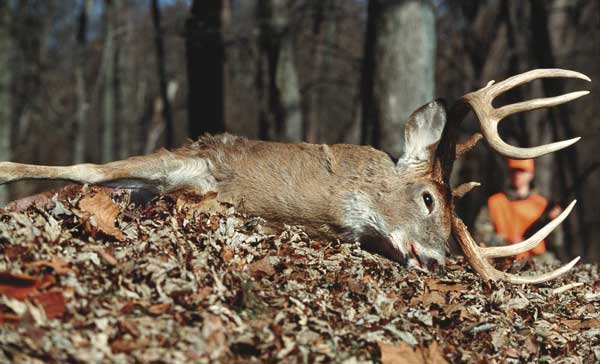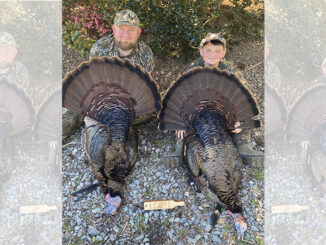
A construction worker from Mocksville visits a favorite haunt in Forsyth County each fall, using scouting, rattling and a deadly eye with his 6-mm rifle to take whopper bucks.
John Baker said he’s nothing special, a 40-year-old construction worker from Mocksville, the county seat of tiny Davie County in North Carolina’s western piedmont.
He hunts whitetails an hour’s drive away in Forsyth County, one of the state’s most-populated, urban areas. He doesn’t have a big, expensive hunting lease — he admits he probably couldn’t afford one.
He hunts at a piece of property with permission of the owner — no money changing hands, no food plots planted, no guarantee he’ll be the only one there with a gun in hand come mid-November.
He doesn’t use cover scents, buck lures, grunt calls or a range-finder. About the only “device” that’s in his tree stand with him, besides a camcorder, is a set of rattling horns — real antlers he got off an eight-pointer he killed years ago.
So how does he kill big bucks? The mounts above his fireplace and on the walls of his shop/storage building look like the kinds of deer Bill Jordan, Eddie Salter and Tom Miranda and famous TV hunters take out of the woods every weekend.
Although none of them come close to the Boone & Crockett Club’s all-time record book, every one of them is a bragging-sized whitetail — and hardly a season goes by without Baker bagging one.
“Well, I guess I’m patient. I can sit still on a good stand,” Baker said. “The place I hunt is a really good place; it’s unusual to go and not see any deer. I’ve hunted it for 15 years, and I knew every twig in there. I can tell you what’s going on all the time.”
If that sounds awfully basic, it probably is.
Baker readily admits he uses a rifle he trusts implicitly — a Remington 742 semi-automatic in 6 millimeter, topped by a 3×9 Leopold scope.
“It’s a ‘shot-placement’ gun,” he said. “People say that a bolt-action is more accurate, but at 200 yards, I can put it on a dime, and I believe in having my second shot ready.
“The only time you really get a good second chance is if you can squeeze the trigger again, right away. You don’t have time to do that with a bolt-action.”
During black-powder season, he shoots a .50-caliber Knight T-Bolt with iron sights. Several of his biggest trophies have been taken with that gun or its predecessor, a .54-caliber Thompson Center.
He carries a portable stand in and out of the woods every day, a Loc-On Lem portable because he’s afraid it might get stolen if he leaves it in a tree for a few days.
He religiously changes stand locations based upon wind direction, and he only puts enough screw-in steps in the tree of his choice to get him 15 feet off the ground.
“I know the higher you get, the better chance they’re not going to see you, but I’d be scared if I got 25 feet off the ground,” he said. “I like the versatility of my little light stand. I can move it around, and I can get in and out of the woods very quietly.
“A lot of people will ride a four-wheeler in, but I like to slip in. It’s like stealth hunting. I’ve got a four-wheeler, but I only ride it in to get one I’ve killed.”
He washes his hunting clothes in Arm & Hammer baking soda before the season and doesn’t wash them again until after the season. He wears them nowhere except into and out of the woods.
“My wife says all time that I smell like the woods,” he said. “That’s what I want.”
Baker’s biggest buck is a 10-pointer with a sticker at the base of one brow tine that scored 142 5/8 points. He has an eight-pointer with a sticker at the base of the same brow tine that scored 141 2/8.
The rest of his trophies, conservatively, are 120- and 130-class bucks with heavy horns — some wide, some tall. Almost all were taken during black-powder season or the first week of gun season — the week of Thanksgiving.
“I hunt only for big bucks now,” said Baker, who regularly takes his 15-year-old daughter, Sabrina, to the woods with him, often setting her up in a stand within 100 yards so he can keep an eye on her.
“If it isn’t worth mounting, I don’t take ’em anymore. I eat deer meet, just not enough to be out taking deer just to be taking them.
“I let does and small bucks walk past — I shoot them with my camcorder. And if you can read sign, you can tell what’s going on.
“I can see when bucks are going from pre-rut to the peak of the rut. Usually that’s the week before Thanksgiving and Thanksgiving week, and that’s when I really stay in the woods.
“I love to start rattling during muzzle-loader season, and I’ll rattle the first week of gun season. I used to not do that; I used to not believe in anything except being there and not smelling.
“But I believe the way it is in North Carolina, you have to use rattling horns at exactly the right time before they really go into the rut. When bucks are already on does, horns won’t pull them off.”
Baker likes to position himself at trails leading from bedding to feeding areas, and he’s especially fond of a 5-acre kudzu patch that has produced several big bucks. He believes the deer feel safe in the thick vines, and he watches for them to move through on the myriad of trails that already exist.
He killed one 8-pointer that was bedded down in the kudzu — Baker was sitting comfortably in his stand when the buck stood up out in front of the hunter, a fatal mistake.
He pays attention to scrapes and rubs, but he’s not wedded to hunting them. He’s much more apt to set up a stand where he’s sure to see lots of does, understanding that as mid-November approaches, finding does means finding bucks. He will put out corn piles to attract does.
“Most of my biggest bucks have been chasing does,” he said. “My biggest was on a corn pile. I knew the rut was coming, and the does were coming to the corn, and he came in smelling the does; he smelled them in the corn pile.”
Baker believes in staying in his stand almost from dawn to dusk. He’ll come out for an hour for lunch in the middle of the day, but he makes it a quick lunch.
Two of his biggest bucks have come during the hour just before noon.
“One year, on opening day of gun season, I had to take Sabrina to the doctor first thing in the morning,” he said. “I got to my tree at about 11 (a.m.); 10 minutes later, I had my hands on a 12-pointer.
“I got in my stand, picked up my rattling horns and rattled for a couple of minutes, then I opened a Pepsi, and here he comes out of a pine thicket, looking pretty and proud. I picked up my rifle and shot him.”
When Baker uses rattling horns, he normally bangs the horns together, then keeps rubbing them back and forth with the horns locked up for about two minutes. He’ll put them down, then repeat his performance 30 minutes later. After that, he keeps quiet.
“I know a big buck can pinpoint you if you’re not concealed,” he said. “He can be standing out there, 100 yards away, looking for you between two branches, and he can see the horns move if you’re rattling too much.
“I think rattling too much can hurt you.”





Be the first to comment